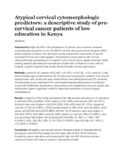| dc.description.abstract | Introduction: high risk HPV is the perpetrator of cervical cancer disease, however screening and vaccination is not included in cervical cancer prevention program within public hospitals in Kenya. This descriptive study assessed the association of specific microbial STI and socio-demographic characteristics and practices with cervical cytomorphologic presentations in regards to pre cervical cancer grades amongst health seeking patients attending the reproductive health clinic of Nakuru County referral hospital, a public hospital under newly devolved health services governance.
Methods: a total of 142 patients (AGC/AIS, n=8; HSIL, n=59; LSIL, n=35; controls, n=40) whose median age ranged between 20-70 years were purposively sampled. A structured questionnaire with closed and open ended entries was administered and STI screening including Pap smear examination for cytomorphological profiling done according to revised 2014 Bethesda classification. Associations were established using chi-square and multivariate logistic regression model to determine prediction of cervical atypia manifestations.
Results: a majority of the study participants had only primary education or no education in AGC/AIS (63%) and HSIL (73%) relative to LSIL (49%) and controls (53%) (P=0.017). Koilocyte rates were higher in AGC/AIS (25%), HSIL (52%) and LSIL (77%) compared controls (12.5%) (P<0.0001). ASCUS predominated in HSIL (61%) and LSIL (86%), while almost all AGC/AIS had AGCUS (88%). HR HPV 16/18 infection rates were higher in AGC/AIS (100%), HSIL (80%) and LSIL (83%) relative to controls (10%) (P<0.0001), and was associated with higher risk of having AGC/AIS (OR, 2.0; 95% CI, 1.940-1.947; P<0.0001); HSIL, (OR, 36.3; 95% CI, 9.5-139.5; P<0.0001); and LSIL (OR, 50.1; 95% CI, 12.0-209.0; P<0.0001).
Conclusion: altogether, pre-cervical cancer in Kenyan women is characterized by koilocytosis and ASCUS probably from the high rates of HPV 16/18 infections. Promoting cancer education and screening for high risk HPV infections and pre-cancerous lesions will improve women's reproductive health. | en_US |

